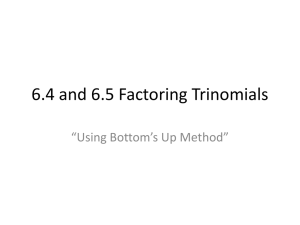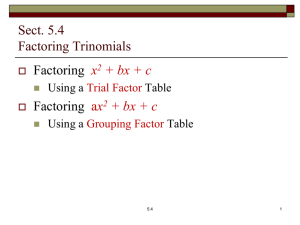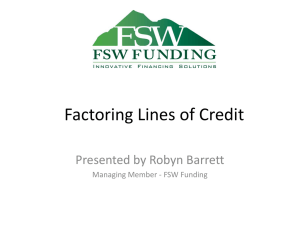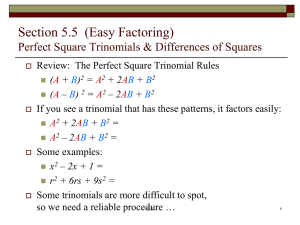8-3 Factoring x^2 + bx + c
advertisement
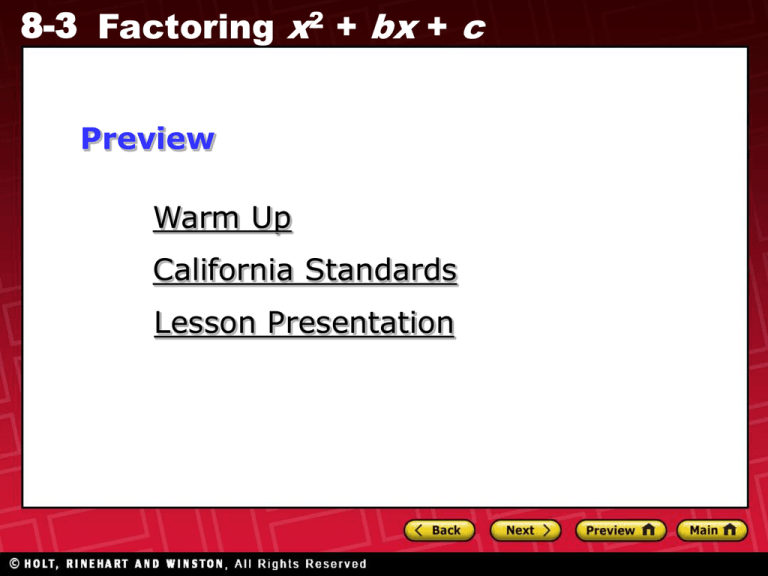
8-3 Factoring x2 + bx + c Preview Warm Up California Standards Lesson Presentation 8-3 Factoring x2 + bx + c Warm Up 1. Which pair of factors of 8 has a sum of 9? 1 and 8 2. Which pair of factors of 30 has a sum of –17? –2 and –15 Multiply. 3. (x + 2)(x + 3) x2 + 5x + 6 4. (r + 5)(r – 9) r2 – 4r – 45 8-3 Factoring x2 + bx + c California Standards 11.0 Students apply basic factoring techniques to second- and simple thirddegree polynomials. These techniques include finding a common factor for all terms in a polynomial, recognizing the difference of two squares, and recognizing perfect squares of binomials. 8-3 Factoring x2 + bx + c In Chapter 7, you learned how to multiply two binomials using the Distributive Property or the FOIL method. In this lesson, you will learn how to factor a trinomial into two binominals. 8-3 Factoring x2 + bx + c Notice that when you multiply (x + 2)(x + 5), the constant term in the trinomial is the product of the constants in the binomials. (x + 2)(x + 5) = x2 + 7x + 10 8-3 Factoring x2 + bx + c Use this fact to factor some trinomials into binomial factors. Look for two integers (positive or negative) that are factors of the constant term in the trinomial. Write two binomials with those integers, and then multiply integers to check. If no two factors of the constant term work, we say the trinomial is not factorable. 8-3 Factoring x2 + bx + c Additional Example 1: Factoring Trinomials Factor x2 + 15x + 36. Check your answer. ( + (x + )( + )(x + ) Write two sets of parentheses. ) The first term is x2, so the variable terms have a coefficient of 1. The constant term in the trinomial is 36. Try factors of 36 for the constant terms in the binomials. (x + 1)(x + 36) = x2 + 37x + 36 (x + 2)(x + 18) = x2 + 20x + 36 (x + 3)(x + 12) = x2 + 15x + 36 8-3 Factoring x2 + bx + c Additional Example 1 Continued Factor x2 + 15x + 36. Check your answer. The factors of x2 + 15x + 36 are (x + 3)(x + 12). x2 + 15x + 36 = (x + 3)(x + 12) Check (x + 3)(x + 12) = x2 + 12x + 3x + 36 Use the FOIL method. = x2 + 15x + 36 The product is the original trinomial. 8-3 Factoring x2 + bx + c Remember! When you multiply two binomials, multiply: First terms Outer terms Inner terms Last terms 8-3 Factoring x2 + bx + c Check It Out! Example 1a Factor each trinomial. Check your answer. x2 + 10x + 24 ( + (x + )( + ) )(x + ) Write two sets of parentheses. The first term is x2, so the variable terms have a coefficient of 1. The constant term in the trinomial is 24. Try factors of 24 for the constant terms in the binomials. (x + 1)(x + 24) = x2 + 25x + 24 (x + 2)(x + 12) = x2 + 14x + 24 (x + 3)(x + 8) = x2 + 11x + 24 (x + 4)(x + 6) = x2 + 10x + 24 8-3 Factoring x2 + bx + c Check It Out! Example 1a Continued Factor each trinomial. Check your answer. x2 + 10x + 24 The factors of x2 + 10x + 24 are (x + 4)(x + 6). x2 + 10x + 24 = (x + 4)(x + 6) Check (x + 4)(x + 6) = x2 + 4x + 6x + 24 Use the FOIL method. = x2 + 10x + 24 The product is the original trinomial. 8-3 Factoring x2 + bx + c Check It Out! Example 1b Factor each trinomial. Check your answer. x2 + 7x + 12 ( + (x + )( + ) )(x + ) Write two sets of parentheses. The first term is x2, so the variable terms have a coefficient of 1. The constant term in the trinomial is 12. Try factors of 12 for the constant terms in the binomials. (x + 1)(x + 12) = x2 + 13x + 12 (x + 2)(x + 6) = x2 + 8x + 12 (x + 3)(x + 4) = x2 + 7x + 12 8-3 Factoring x2 + bx + c Check It Out! Example 1b Continued Factor each trinomial and check. x2 + 7x + 12 The factors of x2 + 7x + 12 are (x + 3)(x + 4). x2 + 7x + 12 = (x + 3)(x + 4) Check (x + 3)(x + 4) = x2 + 4x + 3x + 12 = x2 + 7x + 12 Use the FOIL method. The product is the original trinomial. 8-3 Factoring x2 + bx + c The method of factoring used in Example 1 can be made more efficient. Look at the product of (x + a) and (x + b). x2 ab (x + a)(x + b) = x2 + ax + bx + ab ax bx = x2 + (a + b)x + ab The coefficient of the middle term is the sum of a and b. The third term is the product of a and b. 8-3 Factoring x2 + bx + c 8-3 Factoring x2 + bx + c When c is positive, its factors have the same sign. The sign of b tells you whether the factors are positive or negative. When b is positive, the factors are positive and when b is negative, the factors are negative. 8-3 Factoring x2 + bx + c Additional Example 2A: Factoring x2 + bx + c When c is Positive Factor each trinomial. Check your answer. x2 + 6x + 5 (x + )(x + ) b = 6 and c = 5; look for factors of 5 whose sum is 6. Factors of 5 Sum 1 and 5 6 The factors needed are 1 and 5. (x + 1)(x + 5) Check (x + 1)(x + 5) = x2 + 5x + x + 5 = x2 + 6x + 5 Use the FOIL method. The product is the original trinomial. 8-3 Factoring x2 + bx + c Additional Example 2B: Factoring x2 + bx + c When c is Positive Factor each trinomial. Check your answer. x2 + 6x + 9 b = 6 and c = 9; look for factors of 9 (x + )(x + ) whose sum is 6. Factors of 9 Sum 1 and 9 10 3 and 3 6 The factors needed are 3 and 3. (x + 3)(x + 3) Check (x + 3)(x + 3 ) = x2 + 3x + 3x + 9 Use the FOIL method. The product is the 2 = x + 6x + 9 original trinomial. 8-3 Factoring x2 + bx + c Additional Example 2C: Factoring x2 + bx + c When c is Positive Factor each trinomial. Check your answer. x2 – 8x + 15 (x + )(x + ) b = –8 and c = 15; look for factors of 15 whose sum is –8. Factors of –15 Sum –1 and –15 –16 –3 and –5 –8 The factors needed are –3 and –5 . (x – 3)(x – 5) Check (x – 3)(x – 5 ) = x2 – 5x – 3x + 15 Use the FOIL method. The product is the 2 = x – 8x + 15 original trinomial. 8-3 Factoring x2 + bx + c Check It Out! Example 2a Factor each trinomial. Check your answer. x2 + 8x + 12 (x + )(x + Factors of 12 1 and 12 2 and 6 ) Sum 13 8 b = 8 and c = 12; look for factors of 12 whose sum is 8. The factors needed are 2 and 6 . (x + 2)(x + 6) Check (x + 2)(x + 6 ) = x2 + 6x + 2x + 12 Use the FOIL method. = x2 + 8x + 12 The product is the original trinomial. 8-3 Factoring x2 + bx + c Check It Out! Example 2b Factor each trinomial. Check your answer. x2 – 5x + 6 (x + )(x+ ) b = –5 and c = 6; look for factors of 6 whose sum is –5. Factors of 6 Sum –1 and –6 –7 –2 and –3 –5 The factors needed are –2 and –3. (x – 2)(x – 3) Check (x – 2)(x – 3) = x2 – 3x – 2x + 6 Use the FOIL method. = x2 – 5x + 6 The product is the original trinomial. 8-3 Factoring x2 + bx + c Check It Out! Example 2c Factor each trinomial. Check your answer. x2 + 13x + 42 (x + )(x + ) b = 13 and c = 42; look for factors of 42 whose sum is 13. Factors of 42 Sum 1 and 42 43 2 and 21 23 6 and 7 13 The factors needed are 6 and 7. (x + 6)(x + 7) Check (x + 6)(x + 7) = x2 + 7x + 6x + 42 Use the FOIL method. = x2 + 13x + 42 The product is the original trinomial. 8-3 Factoring x2 + bx + c Check It Out! Example 2d Factor each trinomial. Check your answer. x2 – 13x + 40 b = –13 and c = 40; look for factors of 40 whose sum is –13. (x + )(x+ ) Factors of 40 –2 and –20 –4 and –10 –5 and –8 Sum –22 The factors needed are –5 and –8. –14 –13 (x – 5)(x – 8) Check (x – 5)(x – 8) = x2 – 8x – 5x + 40 Use the FOIL method. = x2 – 13x + 40 The product is the original polynomial. 8-3 Factoring x2 + bx + c When c is negative, its factors have opposite signs. The sign of b tells you which factor is positive and which is negative. The factor with the greater absolute value has the same sign as b. 8-3 Factoring x2 + bx + c Additional Example 3A: Factoring x2 + bx + c When c is Negative Factor each trinomial. x2 + x – 20 (x + )(x + ) Factors of –20 Sum –1 and 20 19 –2 and 10 8 –4 and 5 1 (x – 4)(x + 5) b = 1 and c = –20; look for factors of –20 whose sum is 1. The factor with the greater absolute value is positive. The factors needed are 5 and –4. 8-3 Factoring x2 + bx + c Additional Example 3B: Factoring x2 + bx + c When c is Negative Factor each trinomial. x2 – 3x – 18 (x + )(x + Factors of –18 1 and –18 2 and – 9 3 and – 6 ) Sum –17 – 7 – 3 (x – 6)(x + 3) b = –3 and c = –18; look for factors of –18 whose sum is –3. The factor with the greater absolute value is negative. The factors needed are 3 and –6. 8-3 Factoring x2 + bx + c Helpful Hint If you have trouble remembering the rules for which factor is positive and which is negative, you can try all the factor pairs and check their sums. 8-3 Factoring x2 + bx + c Check It Out! Example 3a Factor each trinomial. Check your answer. x2 + 2x – 15 (x + )(x + ) b = 2 and c = –15; look for factors of –15 whose sum is 2. The factor with the greater absolute value is positive. Factors of –15 Sum –1 and 15 14 –3 and 5 2 The factors needed are –3 and 5. (x – 3)(x + 5) Check (x – 3)(x + 5) = x2 + 5x – 3x – 15 Use the FOIL method. = x2 + 2x – 15 The product is the original polynomial. 8-3 Factoring x2 + bx + c Check It Out! Example 3b Factor each trinomial. Check your answer. x2 – 6x + 8 (x + )(x + Factors of 8 –1 and –6 –2 and –4 ) Sum –7 –6 (x – 2)(x – 4) b = –6 and c = 8; look for factors of 8 whose sum is –6. The factors needed are –4 and –2. Check (x – 2)(x – 4) = x2 – 4x – 2x + 8 = x2 – 6x + 8 Use the FOIL method. The product is the original polynomial. 8-3 Factoring x2 + bx + c Check It Out! Example 3c Factor each trinomial. Check your answer. x2 – 8x – 20 (x + )(x + ) Factors of –20 Sum 1 and –20 –19 2 and –10 –8 (x – 10)(x + 2) b = –8 and c = –20; look for factors of –20 whose sum is –8. The factor with the greater absolute value is negative. The factors needed are –10 and 2. Check (x – 10)(x + 2) = x2 + 2x – 10x – 20 = x2 – 8x – 20 Use the FOIL method. The product is the original polynomial. 8-3 Factoring x2 + bx + c A polynomial and the factored form of the polynomial are equivalent expressions. When you evaluate these two expressions for the same value of the variable, the results are the same. 8-3 Factoring x2 + bx + c Additional Example 4: Evaluating Polynomials Factor y2 + 10y + 21. Show that the original polynomial and the factored form have the same value for y = 0, 1, 2, 3, and 4. y2 + 10y + 21 (y + )(y + ) Factors of 21 Sum 1 and 21 22 3 and 7 10 (y + 3)(y + 7) b = 10 and c = 21; look for factors of 21 whose sum is 10. The factors needed are 3 and 7. 8-3 Factoring x2 + bx + c Additional Example 4 Continued Evaluate the original polynomial and the factored form for y = 0, 1, 2, 3, and 4. y y2 + 10y + 21 y (y + 7)(y + 3) 0 02 + 10(0) + 21 = 21 0 (0 + 7)(0 + 3) = 21 1 12 + 10(1) + 21 = 32 1 (1 + 7)(1 + 3) = 32 2 22 + 10(2) + 21 = 45 2 (2 + 7)(2 + 3) = 45 3 32 + 10(3) + 21 = 60 3 (3 + 7)(3 + 3) = 60 4 42 + 10(4) + 21 = 77 4 (4 + 7)(4 + 3) = 77 The original polynomial and the factored form have the same value for the given values of n. 8-3 Factoring x2 + bx + c Check It Out! Example 4 Factor n2 – 7n + 10. Show that the original polynomial and the factored form have the same value for n = 0, 1, 2, 3, and 4. n2 – 7n + 10 b = –7 and c = 10; look for factors (n + )(n + ) of 10 whose sum is –7. Factors of 10 Sum –1 and –10 –11 The factors needed are –2 and –5. –2 and –5 – 7 (n – 5)(n – 2) 8-3 Factoring x2 + bx + c Check It Out! Example 4 Continued Evaluate the original polynomial and the factored form for n = 0, 1, 2, 3, and 4. n n2 –7n + 10 n (n – 5)(n – 2 ) 0 02 – 7(0) + 10 = 10 0 (0 – 5)(0 – 2) = 10 1 12 – 7(1) + 10 = 4 1 (1 – 5)(1 – 2) = 4 2 22 – 7(2) + 10 = 0 2 (2 – 5)(2 – 2) = 0 3 32 – 7(3) + 10 = –2 3 (3 – 5)(3 – 2) = –2 4 42 – 7(4) + 10 = –2 4 (4 – 5)(4 – 2) = –2 The original polynomial and the factored form have the same value for the given values of n. 8-3 Factoring x2 + bx + c Lesson Quiz: Part I Factor each trinomial. 1. x2 – 11x + 30 (x – 5)(x – 6) 2. x2 + 10x + 9 (x + 1)(x + 9) 3. x2 – 6x – 27 (x – 9)(x + 3) 4. x2 + 14x – 32 (x + 16)(x – 2) 8-3 Factoring x2 + bx + c Lesson Quiz: Part II 5. Factor n2 + n – 6. Show that the original polynomial and the factored form have the same value for n = 0, 1, 2, 3 ,and 4. (n + 3)(n – 2)
